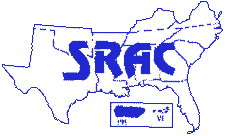
Ponds do not have to be built on
land as flat as the delta regions of
western Mississippi, southeastern
Arkansas or northeastern
Louisiana. There are more than
20,000 acres of catfish production
in slightly hilly areas of
Mississippi, Tennessee, Alabama,
Georgia and Illinois. On rolling
terrain the annual rainfall may be
enough to completely fill and
periodically recharge production
ponds. Such watershed systems
are not so dependent on groundwater.
They also act as flood control
reservoirs and can greatly
reduce erosion on land previously
scarred with unsightly gullies.
Watershed ponds are constructed
by building dams across valleys to
form reservoirs that store rainwater
(Fig. 1). Some aquaculture
facilities have large reservoirs
that, in turn, fill smaller ponds
with captured runoff. Watershed
ponds can be cheaper to build
than levee ponds on flat land and
they dont require expensive
wells.
A disadvantage of deep
watershed ponds is that
they are prone to stratify.
However, most aquaculture
production
ponds are routinely aerated
and adequate aeration
will break up daily
stratification.
Water supplies
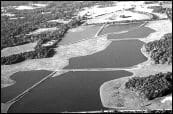 Figure 1: Watershed pond |
The entire watershed area of a proposed pond must be investigated to determine whether runoff might be polluted. Large chicken and hog farms, extensive areas of row crops, grazing livestock, industrial sites and other water quality hazards in the watershed could preclude the operation of a watershed pond. Good watersheds contain wellestablished, undisturbed vegetative cover such as timber or grass.
A buffer zone of grass or sod should surround the pond, especially if there are croplands, concentrated feed lots, or large denuded areas in the watershed. Springs or streams can be used as a water source. Large streams flowing through watersheds may require some kind of diversion device. Streams can be contaminated with wild fish or manmade pollutants, so its a good idea to get the water tested before construction begins. Also, large inflows of soft water in acid soils may hinder any long-term remedial effects of liming.
Proper site selection
When choosing a pond site, consider the soil type, topography, characteristics of the watershed and, of course, safety. A power supply for aeration equipment must also be available.
Soil type
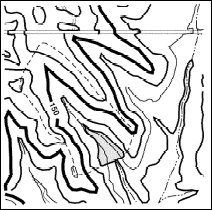 Figure 2: Determining the possibility of a potential pond site and its respective watershed. The dashed lines indicate the boundaries of the watershed. Numbers are elevations in feet. |
Ponds built in limestone areas have been known to drain completely overnight! The type of soil in the dam area is especially critical for safety reasons. Dam seepage can lead to dangerous dam failures. The NRCS and some private agricultural and civil engineers have hydraulic probes that can sample soils several feet down. A backhoe swipe also will help in analyzing soil. Cutoff trenches and dam cores must be located where soil has a high clay content so they will remain structurally sound during the life of the pond.
Topography
The objective is to locate a pond where the largest storage volume is obtained with the least amount of earth fill needed for the dam. Locating a dam between two gently sloped ridges in front of a broad section of valley is ideal. The less pond excavation needed, the more feasible the site and the lower the construction costs.
Safety
Do not locate large dams where their failure could cause loss of life, injury to people or livestock, damage to buildings, or the interruption of the use of railways, highways or public utilities. Aquaculture ponds are not as deep as public reservoirs and dam failures are rare. However, if the site involves some degree of risk to the public, a professional engineer with experience in dam construction should be consulted. Almost every state has a dam safety law. Contact an Extension fisheries specialist or aquaculturist for more information. The location of buried pipelines, electrical lines or telephone wires should be researched before any construction begins. Breaking a fiber optic communication cable will put most pond construction budgets into the red!
Determining an adequate watershed area
The amount and quality of water
entering the pond from the surrounding
watershed is dependent
on several factorsslope, soil
type, vegetative cover and the
amount of precipitation. There are
no set criteria for determining
whether a watershed is sufficient
for a given size pond, but there
are some general rules.
Watersheds containing mostly
pasture with heavy clay soils may
supply 1 acre of water for every 5
acres of land. At the other
extreme, timberland on sandy soil
may require a ratio of 30 acres of
land to 1 acre of water.
Excessively large watersheds can
be just as problematic as limited
watersheds. Too much water may
dilute water amendments such as
lime and salt, allow valuable fish
to escape during floods, and make
it necessary to install expensive
flood or diversion devices. Ponds
with excessive watersheds also
may fill in faster with sediments,
requiring frequent and costly renovations.
An undersized watershed
may cause pond water to
remain shallow, allowing weeds
to get a foothold and preventing
the use of emergency aeration
devices when fish become
stressed.
Pond design and layout
Because of the liability involved with dams, most aquaculturists should confer with a person experienced in the design of commercial aquaculture ponds. The Natural Resources and Conservation Service, a federal agency, offers technical assistance in pond design in most states. This agency designs ponds that incorporate exact safety standards, well-established design criteria, and the latest conservation practices. They are almost always approved by a professional engineer or the NRCS approval authorities. However, the NRCS cant always respond to requests quickly because of its small staff. Private engineers or consultants may be available for a fee. Be sure to get referrals and check any state codes for pond construction before paying for the services of a consultant. A good site survey and layout design will contain the following information:
Location, top width, slopes, earth fill requirements, and elevation of the dam
Emergency spillway location and size
Shoreline dimensions
Soils investigation report
Dimensions of the cutoff trench and core
Location, dimensions and elevations of the riser and barrel pipes
Estimate of the total cut and fill in cubic yards (This figure will account for most of the expense in pond construction.)
Watershed area and characteristics
A bill of materials needed, including valves, concrete and lumber for the pipe ballast, pipes, vegetative materials (seed, fertilizer, lime), and any diversion pipes or valves
Pond sizing and depth
The size of a watershed pond should be based on the availability of water from the watershed. The water should be deep enough to compensate for evaporation and seepage. Even during summer drought the water should be at least 3 to 4 feet deep. Ideally, the average water depth in a commercial watershed pond should be 4 to 5 feet. The maximum depth should be 8 to 10 feet because of the limited size of commercial seines. Ponds that can be seined without releasing water are called seine-through ponds. Catfish ponds in the southeastern United States are seldom drained for harvest.
Other design features
Since catfish and most other finfish
ponds are always seined for
harvesting, pond bottoms should
be smooth and almost flat.
Stumps and other natural obstructions
should be removed.
Watershed ponds need not be rectangular
or square in shape.
Curvilinear shorelines will work
as long as the maximum width of
the pond doesnt exceed the
length of the seines used for harvesting.
Most seines used by custom
seiners and processing plants
are 1,000 to 1,500 feet long. Ideally
the seine will have some slack or
curvature, so maximum pond
widths should be about 700 to
1,000 feet.
The dam should have a minimum
inside slope of 3:1, 4:l if economically
feasible. A 4:1 slope makes it
easier and safer to position emergency
aerators and load and
unload boats. It also reduces wave
erosion and makes for better seine
contact with the bottom at the
inside toe of the levee. However,
4:1 slopes are more expensive
because there must be more earth
fill. The outside slope can be 3:1.
This slope will allow for maintenance
duties such as bush hogging
and driving around emergency
aeration equipment with
pickup trucks.
Occasionally it is necessary to
drain a pond to capture large,
seine-wary fish, repair drains or
renovate banks. Pond bottoms
should be graded toward the
drain at a 0.1 to 0.3 percent fall to
ensure complete drainage and
allow fish to concentrate in the
deeper end.
Pond construction: Contractors
Pond contractors run the gamut from fly-by-night operators to companies that have their own engineers and use laser devices for leveling. It is always a good idea to get references for work already completed. If possible, get competitive bids from several contractors, check out their references, and then decide. Be sure to establish specifics about what is to be done by whom, the quality of material and workmanship required and payment details. Some companies prefer to do turn-key jobs, from building the pond to planting the dam with grass. Contractors are usually paid by the number of cubic yards of dirt moved so a good estimate of earth fill is needed. A welder will be needed to fabricate the drainage structures so be sure to negotiate who will be responsible for this phase of construction.
Construction costs
Pond construction costs can be highly variable. On a per-acre basis, large ponds are much cheaper to build than small ones. Data at the Alabama Fish Farming Center in Greensboro indicate that watershed ponds larger than 15 acres cost less than $1,000 per acre to build in ideal locations. This includes clearing, earth fill, excavation, pipe and valve, concrete, seeding and dam gravel. Ponds smaller than 10 acres may cost as much as $1,800 per acre. Ponds on poor sites, i.e., on sites that are steep and require large dams to impound relatively small acreages, may cost $10,000 or more per acre. The largest cost of building a pond is earthmoving. All other costs are relatively minor. Contractors in commercial catfish areas currently charge $.70 to $1.25 per cubic yard of dirt moved. Costs will no doubt continue to rise as machinery, fuel and labor costs increase.
Equipment needed
Pond construction equipment may include the following: large and small bulldozers for clearing and final dressing of levees; self-loading scrapers or tractor-pulled pans; laser leveling and welding equipment; backhoes and hydraulic excavators; farm tractors with soil implements such as cultivators or discs; and a sheepsfoot roller (Fig. 3).
Building a watershed pond
 Figure 3: Farm tractor with pan. |
The next step is dam construction. A cutoff trench is excavated along the centerline of the dam; it extends up each abutment as far as there is any pervious material that might allow seepage (Fig. 5). Any potential seepage must be prevented to avoid water loss and failure of the dam. The bottom of the trench should be at least 8 feet wide with sides no steeper than 1:1. Old stream channels running through the dam should be cleaned out. All stones, gravel, sand, sediment or anything else that would prevent bonding of the earth fill and dam foundation must be removed.
Before filling the cutoff trench with the best available clay soil, the trench may have to be pumped out and lightly scarified. The clay fill should be compacted tightly as each layer is added to the trench. If properly compacted, the clay will strengthen the dam. Eventually the trench will be filled and then the remaining dam core will be constructed above ground. The core of the dam must be as high as the permanent water elevation. Allow 5 to 10 percent for settlement.
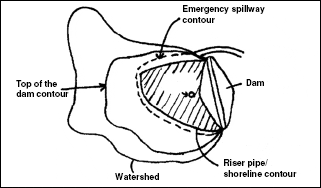 Figure 4: Pond contour examples. |
Soil moisture and compaction
Good compaction requires suitable moisture and compactive effort. The dam must be built gradually in layers of 6 to 8 inches and each layer packed with heavy equipment or sheepsfoot rollers. The soil used in the dam must be free of all vegetation, roots and large rocks. Soil moisture is critical. Soil too wet or too dry will not adequately compact no matter how many times its run over. If the soil is so dry it cant be hand molded, stop construction or add water with large tank sprayers. If the soil is so wet that it adheres to construction equipment, stop or, if possible, find drier material. Most dam seepage problems occur because dams were built during drought conditions.
Constructing the pond area
Water depth at the shoreline
should be at least 3 feet, with a
minimum 3:1 slope. This will
eliminate most aquatic weed
problems and allow for emergency
aeration anywhere in the
pond. The bottom should be level
and graded to the lowest point in
front of the dam where the barrel
pipe will be located. The bottom
should also be pulverized with a
disc harrow and then leveled. If
agricultural lime is required,
spread it before filling the pond
with water.
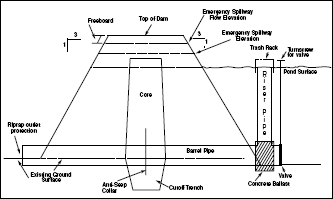
Figure 5: Typical cross-section of dam at the pipe.
Installing the drainage pipe
Typically, the barrel pipe with
anti-seep collars attached is
installed after the dam core has
been partially constructed above
ground (Fig. 5). The dam core is
trenched down to the bottom of
the pond and a barrel pipe with
anti-seep collars is laid in the
trench. Anti-seep collars are
required because water will seek
the path of least resistance. This is
most likely to be alongside a
straight barrel pipe. Anti-seep collars
are simply steel plates welded
vertically and completely around
the barrel pipe to provide the necessary
resistance to laminar flow.
The connection must be watertight.
If the dam is taller than
fourteen feet, more than one collar
will be needed. And be sure the
barrel pipe has a slight fall to the
outside of the dam so the pond
completely drains.
Compaction around the barrel
pipe is extremely important. This
is the weakest area of the dam
and the cause of most dam failures.
The fill should be compacted
with power tampers to ensure
good compaction against the pipe
and the collars. Manual compaction
should continue until
there is at least 2 feet of material
over the pipe.
Riser pipes can be located inside
or outside of the pond area.
Locating pipes inside the pond
area reduces the chance of vandals
tampering with drains. One
disadvantage of locating them
inside the pond, however, is that
it will interfere with seining. A
disadvantage of locating the riser
outside the pond is that the riser
and barrel pipe are hydraulically
charged or pressurized at all times
so all the welds must be good or
leaks will develop and cause the
dam to fail. Risers placed outside
of the pond area will have to be
larger because of the reduced
head pressure on the pipe opening.
The dams freeboard may
have to be increased also, adding
to the expense. Large watersheds
may preclude the outside placement
of the riser for safety reasons.
In colder, northern climates
outside risers may freeze. Riser
placement should be a carefully
engineered consideration.
A canal gate or alfalfa valve is
installed to regulate discharge.
Concrete ballasts
If an inside riser is installed, there must be a concrete ballast to counteract buoyancy forces of the water on the riser pipe. Steel pipes, like battleships, have a tendency to float. Buoyant forces are created when any object is submerged in water, whether or not the object is heavier than water. When an object is submerged in water, a force equal to the weight of the water displaced acts upward on the object. A 24-inch riser 10 feet tall will have a buoyant force of 1,372 pounds. In order to counteract this force, 0.6 cubic yards of concrete must be poured around the base of the riser. This amount of concrete weighs 2,430 pounds in the air but only 1,419 pounds under water (again because of the buoyant force on the concrete). Without a ballast, constant upward forces on the riser pipe will weaken any joints over time and may crack welded seams. Also, water flowing through the pipe causes vibrations and movement. The ballast acts as a damper, adding longevity to the pipe system.
Sizing riser and barrel pipes
The characteristics of the watershed and the typical rainfall in the area are used to size riser and barrel pipes. Riser pipes are larger in diameter than barrel pipes. They are welded together in a tee. Riser pipes are usually designed for 5-year storms, or rainfalls that occur normally once every 5 years for a 24-hour period. For the west central area of Alabama, this is about 5 to 6 inches of rain. Of course, the larger the pond and watershed, the larger the riser must be. Barrel pipes are similarily sized. It is obviously better to oversize pipes than to undersize them.
Emergency spillways and dam freeboards
Emergency spillways are required,
particularly if ponds are located
on large watersheds. Spillways
can discharge large volumes of
water around the dam. If properly
designed, they will prevent water
from overtopping the dam.
Spillways are designed large
enough to handle a 25-year storm.
This size storm also establishes
the top-of-the-dam elevation that
includes adequate freeboardthe
distance between the designed
flow of the emergency spillway
and the top of the dam. This critical
dimension is a minimum of 1
foot (Fig. 5).
There should be a
vertical drop where the spillway
discharges into a natural watercourse
to discourage wild fish
from entering the production
pond. The spillway should be
transversely flat, shallow, and
grassed to minimize any channeling
of water by erosion. The proper
sizing of emergency spillways
should be determined by qualified
persons, especially if dams are
located in potentially hazardous
areas.
Establishing vegetation
Some new pond owners pay a lot
for pond construction and then
neglect to finish the project.
Unless the soil is protected it may
wash into the bottom of the pond.
Gullies and rills can develop with
the first rainfall, making maintenance
difficult and even jeopardizing
the integrity of the dam.
To prevent this, vegetation should
be established as quickly as possible.
If surface soil was stockpiled
before construction, use it to top
dress banks and dams. This will
promote quick and stable vegetative
cover. Soil on slopes should
be roughed up with a disc or
spike harrow. This encourages
rainfall to soak in instead of running
off and reduces erosion.
Distribute lime, fertilizer, seed and
mulch at recommended rates.
Depending on the season, plant
warm or cool season grasses.
Check with your county
Extension office for recommendations.
All-weather gravel roads to and
on the dam are necessary for
checking water quality, operating
and maintaining aerators, and
carrying out stocking and harvesting
operations. If banks have
good sod cover, it shouldnt be
necessary to have gravel completely
around the pond.
A trash rack should be installed
on top of the riser if it is located
inside the pond. This keeps
debris from entering the pipe and
clogging it.
For more information on watershed
pond construction please
contact the NRCS office and the
Extension aquaculture specialist
in your area.
Material for this publication was
partially derived from NRCS
information, the publication
Pond Building: A guide to planning,
constructing, and maintaining
recreational ponds (ANR-
114, Alabama Cooperative
Extension System, by Chris Hyde
and Perry Oakes), and Channel
Catfish Culture, edited by C. S.
Tucker.
The author thanks Bill Kyser of
Kyser Catfish Farms, Wilmer
Penner of Penner Pond
Construction and Bill Hemstreet
for critically reviewing the manuscript,
and Mickey Barton, Gayle
Barnette and Bruce Dupree for
their assistance with the drawings.
Source: Southern Regional Agricultural Center and the Texas Aquaculture Extension Service - Taken from site - February 2006

